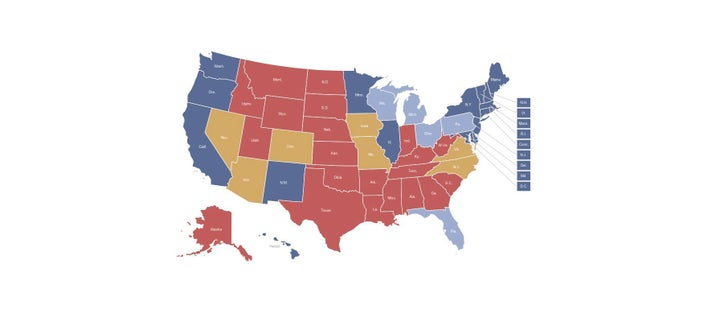
One of my Facebook friends recently posted a link to an article from the National Review Online (NRO) suggesting that Congressional Republicans "propose a 'tax Blue America' plan." It isn't entirely clear whether the NRO suggestion is meant to be taken as a serious proposal, but the article does specify a set of tax increases that apparently would hit the "bluest" states the hardest.
The most popular of the ensuing comments on my friend's Facebook page was a riposte suggesting that somebody should put forward a plan to cut services primarily to the reddest states. This led to a bit of back-and-forth about red states and blue states, about taxes and entitlements, and about what parts of the country "support" what other parts of the country.
Such simplistic reductions of states to monochromatic hues have become the norm over the past decade, and they can be taken to absurd extremes. For example, a couple of days ago I can across a comment on a conservative website suggesting a conspiracy behind the labeling of Republicans as "red" and Democrats as "blue," because Democrats are communists and communism is red and so Democrats ought to be called "red" and Republicans "blue." That conspiracy-minded individual has decided to always refer to Republicans as blue no matter how confusing that might be.
Like many Americans, I, too, find myself routinely thinking in terms of red states and blue states, but I want to break out of that habit. I think it is important to recognize that every state (and not just the so-called purple swing states) contains a rich mix of Republicans and Democrats. Such an obvious fact too often gets forgotten.
Instead of thinking about red states and blue states, I want to start thinking in terms of the people around me in a restaurant. Imagine stepping into the dining room of a restaurant known to be a local institution. Inside you see ten tables, each with five patrons. Here in New York (one of the country's reliably blue states), six of the tables would be Democrats and four would be Republicans. That's a pretty even split. A similar split would be found in red-state Arkansas, but with the proportions reversed. Down in heart-of-Dixie Mississippi, the restaurant would have five tables of Republicans, four of Democrats, and one featuring mixed company.
Even in those states colored more deeply as either red or blue, the dining-crowd metaphor can be clarifying. In county-level maps showing the results of last month's presidential election, there were two states colored completely red, and three states colored completely blue. Not a single county in either Oklahoma or Utah had a majority vote for President Obama, and no county in Hawaii, Massachusetts, or Vermont had a majority vote for Mitt Romney.
The "bluest" county in all-blue Massachusetts was Suffolk County, where President Obama won 77.6 percent of the vote. Even there, our hypothetical restaurant would have two tables of Republicans enjoying (or at least trying to enjoy) their dinner alongside the eight tables of Democrats.
Perhaps the only county in the country where you wouldn't be able to assemble even a single table of the minority party is King County, Texas, where President Obama won just five of the 145 votes cast. Of course, King County (population 286) probably doesn't have any sit-down restaurants, anyway, so the few lonely Democrats living there don't have to worry about not finding a table to sit at.
The point to all of this is that if you are a Republican living in a "blue" state, or if you are a Democrat living in a "red" state, you are less alone than some people would like you to believe. Conversely, if you are living in a state that went the way you voted last month, don't presume that everyone around you shares your politics. Anywhere you go you are going to run into people who voted the other way. That's not a bad thing, and they aren't bad people.
Using the restaurant analogy as a frame of reference for the argument that blue states support red states results in something like this: thirty Democrats and twenty Republicans in one state support twenty Democrats and thirty Republicans in another state. There is no "us" versus "them" when seen this way.
In short, while there may be political polarization in this country, the polarization really isn't based on states. More importantly, while demonizing whole states may feel good, it does little to illuminate the complex realities of American politics. So I'd like to suggest that unless we're in the midst of a presidential campaign, we should all stop talking about "red" states and "blue" states and get back to talking about ourselves as fellow Americans.
